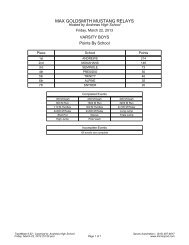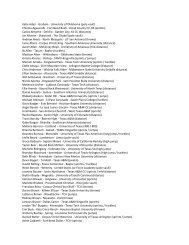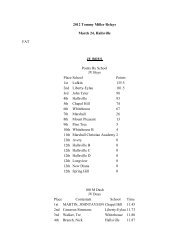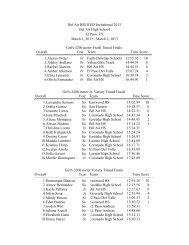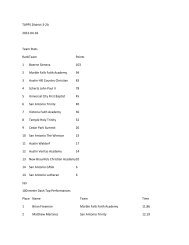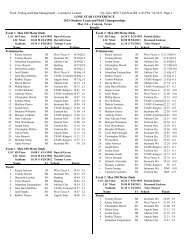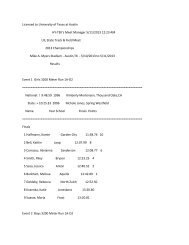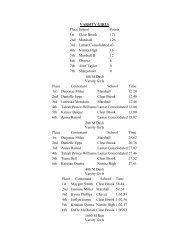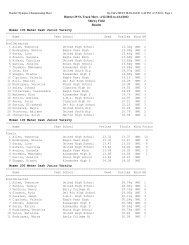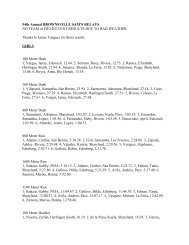1. PAGES 1-35 - Texas Track & Field Coaches Association
1. PAGES 1-35 - Texas Track & Field Coaches Association
1. PAGES 1-35 - Texas Track & Field Coaches Association
Create successful ePaper yourself
Turn your PDF publications into a flip-book with our unique Google optimized e-Paper software.
KIRBY LEE PHOTOGRAPH<br />
COACHES ARE ALWAYS<br />
SEARCHING FOR WAYS<br />
TO GIVE ATHLETES ANY<br />
EXTRA ADVANTAGE<br />
OVER OTHER TEAMS<br />
AND ATHLETES.<br />
One edge that has been the focus of<br />
much research is the enhancement of<br />
athlete confidence for the potential<br />
effects of heightened confidence on performance.<br />
In recent literature, studies<br />
by Craft, Magyar, Becker, and Feltz<br />
(2003) and Mamassis and Doganis<br />
(2004) found that of the indices measured<br />
by the Competitive State Anxiety<br />
Inventory-2 (CSAI-2), self-confidence<br />
best predicted performance in athletic<br />
events. Bandura (1997), considered to<br />
be an expert on self-efficacy and related<br />
topics such as confidence, concluded<br />
that while self-efficacy was not a substitute<br />
for physical talent, it was surely one<br />
of the co-determinants of athletic<br />
prowess and in contests of evenlymatched<br />
opponents, “Perceived efficacy<br />
emerges as the sole determinant of overtime<br />
performance” (p. 383). It would<br />
appear, therefore, that while a coach’s<br />
primary job is to instruct athletes on the<br />
finer points of the sport itself, one of the<br />
most helpful things a coach could do for<br />
the athletes’ overall performance would<br />
be finding ways to improve their selfconfidence<br />
and self-efficacy.<br />
Upon closer investigation into sources<br />
of sport self-confidence, it was apparent<br />
that mental preparation and, more<br />
specifically, motor imagery were major<br />
determinants of athletes’ sport confidence<br />
levels (Cumming, Olphin, & Law,<br />
2007; Hays, Maynard, Thomas, &<br />
Bawden, 2007; Thomas, Maynard, &<br />
Hanton, 2007; Short & Short, 2005).<br />
Motivational General-Mastery (MG-M)<br />
imagery was defined as imagery which<br />
focused particularly on an athlete’s control<br />
and confidence in a difficult situation<br />
(Hall, Mack, Paivio, & Hausenblas,<br />
1998). The purpose of this inquiry,<br />
therefore, was to determine whether<br />
weekly use of MG-M imagery exercises<br />
by NCAA Division III track athletes<br />
would enhance the sport confidence of<br />
those athletes, as quantified by Vealey’s<br />
(1986) Trait Sport Confidence Inventory<br />
(TSCI), which was found to be a valid<br />
and reliable measure of sport confidence<br />
in previous research. The goal<br />
was to develop a mental imagery routine<br />
that coaches and athletes could use to<br />
build athletes’ confidence, and therefore<br />
improve performances, in their athletic<br />
endeavors now and in the future.<br />
METHODS OF RESEARCH<br />
PARTICIPANTS<br />
Ten collegiate track and field athletes<br />
from a rural Division III institution volunteered<br />
to participate in the imagery<br />
sessions. They ranged in age from 18 to<br />
21 years, consisting of five males and<br />
five females with seven being<br />
Caucasians and three being African-<br />
Americans. The athletes competed in<br />
the sprinting, jumping, hurdling, and<br />
throwing events in track and field, comprising<br />
a wide range of competitive<br />
events. Results were gathered for seven<br />
total participants after three athletes<br />
elected to discontinue their participation.<br />
All athletes followed the intervention<br />
and procedures as detailed below<br />
until they eliminated themselves from<br />
the study.<br />
INSTRUMENTS<br />
In this study, the quantitative instrument<br />
of measure was the TSCI (Vealey,<br />
1986), which assessed subjects’ sport<br />
confidence. The inventory consisted of<br />
13 items answered using a nine-point<br />
Likert scale, with “1” representing “low”<br />
confidence and “9” representing “high”<br />
confidence. Before responding to the<br />
items, instructions directed athletes to<br />
base their responses on how confident<br />
they “generally feel” when competing in<br />
sport. Instructions also indicated that<br />
athletes were to compare their confidence<br />
levels to the “most self-confident<br />
athlete” they knew. The test-retest reliability<br />
of the TSCI was found to be very<br />
high (r = .86), and the inventory was<br />
shown to be valid with significant correlations<br />
to other measurements of selfconfidence<br />
among athletes.<br />
AUGUST 2011 techniques 37



